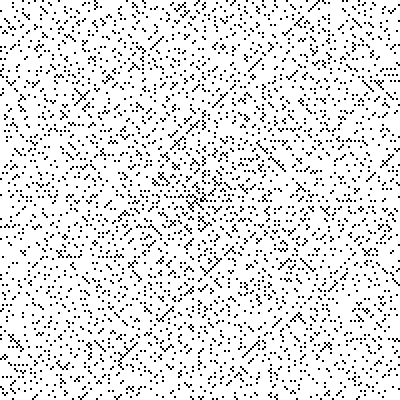 I recently went to Tao's Clay–Mahler Lecturer at UNSW, which was a fascinating look at prime numbers. I managed to grab Terence for a quick chat. Listen to this podcast here:
I recently went to Tao's Clay–Mahler Lecturer at UNSW, which was a fascinating look at prime numbers. I managed to grab Terence for a quick chat. Listen to this podcast here:Primes are integers that can only be divided by themselves and one. For example, the number 10 can be divided by 1, 2, 5 and 10 - whilst the number 11 can only be divided 1 and 11. The first few primes are:
2, 3, 5, 7, 11, 13, 17, 19, 23, 29, 31, 37, 41, 43, 47, 53 ....
One of the interesting things about the primes is that there is no known formula yielding all of them - you can't simply plug a few numbers into a formula to generate a list of the primes. However, on a large scale, their distribution can be modelled. The primes behave as if they are distributed pseudorandomly - see the picture on the right. Each dot in this Ulam spiral represents a prime number - you start in the middle, and wind outwards like a spiral - each dot is a prime, whilst empty space is a non-prime. Whilst you can see various patterns, nothing is predictable.
The prime number theorem says that the probability of a given number n being prime is inversely proportional to its logarithm. Euclid proved that there are infinitely many prime numbers way back in 300BC - see Euclid's Theorem for more. The current largest known prime was discovered in 2008 by the distributed computing project Great Internet Mersenne Prime Search and has 12,978,189 digits:
- 243,112,609 − 1.
Terence Tao, along with Ben Green, proved that the sequence of prime numbers contains arbitrarily long arithmetic progressions - this is the Green-Tao theorem. What this means is that for any number k, there is an arithmetic progression of primes k long. An arithmetic progression is one in which the difference between two numbers in the progression is the same. For example, the series 2, 4, 6, 8, 10... is an arithmetic progression with common difference 2. Green and Tao proved that such sequences exist within the primes for any length of series you want. For example, the series 3, 7, 11 is a prime sequence of length 3 with common difference 4. The series 3, 5, 7 is length 3 with common difference 2. The current record is a series of 25 primes.
I have just finished reading the excellent book The Music of the Primes by British author Marcus du Sautoy - I highly recommend it. It details the story of the Riemann hypothesis which is considered by many to be the most important unresolved problem in mathematics. A solution to the Riemann hypothesis could make an immense contribution to our understanding of the distribution of prime numbers. You certainly don't need to be a maths geek to understand this book - it is a great historical tale. You can buy the book from Amazon here.
I chatted to Terence briefly after his talk, but being the amateur journalist I am, my recorder ran out of batteries! Not to fear, I have added an interview Terence did with Australia radio station Triple J's current affair program Hack - this interview has been reproduced with the permission of the executive producer, best brother James West - it's nice to have a proper professional journo in the family! The interviewer is Kate O'Toole. Listen to this podcast here:
God may not play dice with the universe, but something strange is going on with the prime numbers - Paul Erdos












Great Blog. Thanks for sharing this blog with us. Want to know more about it to enhance my knowledge.
ReplyDeleteprime scales
Post writing is also a excitement, if you know then you can write otherwise it is
ReplyDeletedifficult to write.
Stop by my site – 강남오피
(jk)
I feel like I need to learn and discover more about it here. https://www.windowcleanerscoquitlam.com
ReplyDeletePeel HR is your go-to Staffing Agency Brampton , connecting top talent with leading organizations across Canada. As a top-rated recruitment agency, we ensure a seamless hiring process for both employers and job seekers. Trust Peel HR to help you find the right fit! Visit Peelhr.com for more information.
ReplyDelete